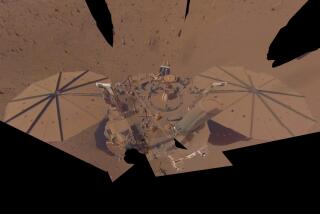Building blocks of life are found on asteroid
- Share via
For the first time, scientists have discovered evidence of water ice, as well as organic compounds, on an asteroid -- findings that bolster a leading theory for the origins of life on Earth.
“Up until now there was no sign that asteroids had any abundant organics or ice on them,” said Joshua P. Emery, a planetary astronomer at the University of Tennessee and an author of one of two studies on the discoveries. The new evidence supports the possibility that the essential building blocks of life came from asteroids.
The research, reported by two teams of scientists working independently, appeared online Wednesday in the journal Nature. Both teams’ conclusions are based on analyses of infrared light reflected by 24 Themis, one of the largest asteroids in the solar system.
Because different materials absorb light at different wavelengths, scientists were able to establish the content of the asteroid by analyzing the light reflected by it. The asteroid contains water and organic compounds, or molecules containing carbon, the teams concluded. With water, such molecules are the building blocks for producing and sustaining living things.
Humberto Campins, an astronomer at the University of Central Florida and lead author of the other study, said his team chose 24 Themis for a closer look because two smaller asteroids in the Themis family seemed to have dust tails. Such tails had not been seen on asteroids, regarded as dry and rocky bodies, but rather on ice-filled comets -- forming when ice on the comets becomes gas without first becoming a liquid and then mixes with dust from the comet.
Emery’s team was looking at the presence of hydrated minerals, commonly found on Earth as clay, at different areas in the solar system. These hydrated minerals are silicates that have been chemically bound to water molecules.
Both teams chose to examine the 120-mile-wide 24 Themis because it is one of the largest, brightest asteroids in the system, and thus one of the easiest to analyze.
The researchers are unsure in what amounts or proportions the water and organic molecules exist.To determine 24 Themis’ precise composition, someone -- or something -- would have to collect a sample from the asteroid, the researchers say. Instead, researchers hope to look at other asteroids in the Themis family to see whether more asteroids hold water -- or whether scientists just got lucky.
Henry H. Hsieh, an astronomer at Queen’s University in Britain, said, “It’s surprising that it’s [evenly distributed] on the surface....This adds a new twist to ice and asteroids.”
The water on the surface must be replenishing itself from within, said Hsieh, who wrote a commentary in Nature on the research, because it’s unlikely that surface ice could have survived for the 4.5 billion years that the asteroid has probably been floating through space.
“Because the temperature in the asteroid belt is such that water ice is not stable over that period of time, it should be baked away by the sun,” Hsieh said.
The possibility that water could have come from asteroids adds weight to the theory that water and organic molecules -- the bricks and mortar for creating life -- may not have originated on Earth. As Campins pointed out, Earth did not become conducive to water or organic molecules until relatively recently.
“In the Earth’s early history, it was very hot liquid molten rock, and if the Earth had any organic molecules back then, they were burned in that stage of its evolution,” Campins said. “As the crust solidifies, it is subsequent impacts with asteroids or comets that brought the building blocks of life.”
amina.khan@latimes.com







